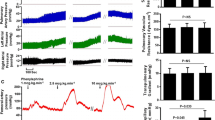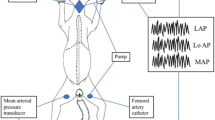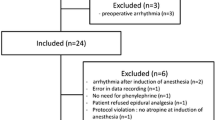Abstract
ATP and diadenosine tetraphosphate (AP4A) have been shown to produce vasodilation mediated by P1- and P2-purinoceptor, respectively. The differing mechanisms involved in this vasodilating activity may induce different systemic hemodynamic changes. We compared the hemodynamic effects of AP4A-induced hypotension with those induced by ATP. Fourteen mongrel dogs were anesthetized with 0.87% halothane in oxygen (1 MAC). After the baseline period, mean arterial pressure was reduced to 60 mmHg for 60 min by the infusion of AP4A or ATP. The ATP- and AP4A-induced hypotension resulted in a maximum reduction in systemic vascular resistance of 43% and 46%, respectively (P<0.01), associated with a significant increase in stroke volume index. With ATP, a 20% of maximum increase (P<0.05) in cardiac index (CI) was observed during the induced hypotension. In contrast, AP4A-induced hypotension did not result in any changes in CI throughout the observation period. The varying results concerning CI during the ATP- and AP4A-induced hypotension were probably due to differences in ventricular filling pressure, since AP4A-induced hypotension was associated with decreases (P<0.01) in both right atrial and pulmonary capillary wedge pressures, whereas neither of these variables significantly changed with ATP. The hypotension induced by either ATP or AP4A was associated with a significant decrease in heart rate (HR). However, both the magnitude and duration of decreases in HR due to ATP-induced hypotension were more pronounced than those seen with AP4A. In conclusion, while both drugs were equally capable of inducing hypotension, our results suggest that AP4A was more suitable for induced hypotension because of its potent vasodilatory action with venodilation and less negative chronotropic action.
Similar content being viewed by others
References
Flodgaard H, Klenow H (1982) Abundant amounts of diadenosine 5′,5′''-P1, P4-tetraphosphate are present and releasable, but metabolically inactive, in human platelets. Biochem J 208:737–742
Lüthje J (1989) Origin, metabolism and function of extracellular adenine nucleotides in the blood. Klin Wochenschr 67:317–327
Burnstock G, Buckley NJ (1985) The classification of receptors for adenosine and adenine nucleotides. In: Paton DM (ed) Methods in pharmacology, vol 6: Methods used in adenosine research. Plenum, New York, pp 193–212
Van Calker D, Müller M, Hamprecht B (1979) Adenosine regulates via two different types of receptors, the accumulation of cyclic AMP in cultured brain cells. J Neurochem 33:999–1005
Burnstock G, Kennedy C (1985) Is there a basis for distinguishing two types of P2-purinoceptor? Gen Pharmacol 16:433–440
Pearson JD, Carleton JS, Gordon JL (1980) Metabolism of adenine nucleotides by ectoenzymes of vascular endothelial and smooth-muscle cells in culture. Biochem J 190:421–429
Sollevi A, Lagerkranser M, Andreen M, Irestedt L (1984) Relationship between arterial and venous adenosine levels and vasodilatation during ATP- and adenosine-infusion in dogs. Acta Physiol Scand 120:171–176
Lüthje J, Ogilvie A (1988) Catabolism of Ap4A and Ap3A in whole blood. The dinucleotides are long-lived signal molecules in the blood ending up as intracellular ATP in the erythrocytes. Eur J Biochem 173:241–245
Goldman SG, Gordon EL, Slakey LL (1986) Hydrolysis of diadenosine 5′, 5′'-P′, P′'-triphosphate (Ap3A) by porcine aortic endothelial cells. Circ Res 59:362–366
Busse R, Ogilvie A, Pohl U (1988) Vasomotor activity of diadenosine triphosphate and diadenosine tetraphosphate in isolated arteries. Am J Physiol 254 (Heart Circ Physiol 23): H828-H832
Boarini DJ, Kassell NF, Sprowell JA, Olin JJ, Coester HC (1984) Adenosine triphosphate-induced arterial hypotension in the dog. Neurosurgery 15:325–331
Van Aken H, Puchstein C, Fitch W, Graham DI (1984) Haemodynamic and cerebral effects of ATP-induced hypotension. Br J Anaesth 56:1409–1415
Kien ND, White DA, Reitan JA, Eisele Jr JH (1987) Cardiovascular function during controlled hypotension induced by adenosine triphosphate or sodium nitroprusside in the anesthetized dog. Anesth Analg 66:103–110
Korlén K (1988) Contral and regional haemodynamics during controlled hypotension produced by adenosine or sodium nitroprusside and nitroglycerin. Studies in the pig. Br J Anaesth 61:186–193
Sollevi A, Lagerkranser M, Irestedt L, Gordon E, Lindquist C (1984) Controlled hypotension with adenosine in cerbral aneurysm surgery. Anesthesiology 61:400–405
Öwall A, Lagerkranser M, Sollevi A (1988) Effects of adenosine-induced hypotension on myocardial hemodynamics and metabolism during cerebral aneurysm surgery. Anesth Analg 67:228–232
Öwall A, Sollevi A (1991) Myocardial effects of adenosine-and sodium nitroprusside-induced hypotension: A comparative study in patients anaesthetized for abdominal aortic aneurysm surgery. Acta Anaesthesiol Scand 35:216–220
Kassell NF, Boarini DJ, Olin JJ, Sprowell JA (1983) Cerebral and systemic circulatory effects of arterial hypotension induced by adenosine. J Neurosurg 58:69–76
Lagerkranser M, Irestedt L, Sollevi A, Andreen M (1984) Central and splanchnic hemodynamics in the dog during controlled hypotension with adenosine. Anesthesiology 60:547–552
Newberg LA, Milde JH, Michenfelder JD (1985) Cerebral and systemic effects of hypotension induced by adenosine or ATP in dogs. Anesthesiology 62:429–436
Hoka S, Siker D, Bosnjak ZJ, Kampine JP (1987) Alteration of blood flow distribution and vascular capacitance during induced hypotension in deafferented dogs. Anesthesiology 66:647–652
Catravas JD (1984) Removal of adenosine from the rabbit pulmonary circulation, in vivo and in vitro. Circ Res 54:603–611
Verhaeghe RH (1977) Action of adenosine and adenine nucleotides on dogs' isolated veins. Am J Physiol 233:H114-H121
James TN (1965) The chronotropic action of ATP and related compounds studied by direct perfusion of the sinus node. J Pharmacol Exp Ther 149:233–247
Hedqvist P, Fredholm BB (1979) Inhibitory effect of adenosine on adrenergic neuroeffector transmission in the rabbit heart. Acta Physiol Scand 105:120–122
Fredholm BB, Sollevi A (1986) Cardiovascular effects of adenosine. Clinical Physiol 6:1–21
McCormack DG, Clarke B, Barnes PJ (1989) Characterization of adenosine receptors in human pulmonary arteries. Am J Physiol 256 (Heart Circ Physiol 25): H41-H46
Hasséssian H, Burnstock G (1995) Interacting roles of nitric oxide and ATP in the pulmonary circulation of the rat. Br J Pharmacol 114:846–850
Author information
Authors and Affiliations
About this article
Cite this article
Takeda, S., Inada, Y., Fukui, N. et al. Comparative hemodynamic effects of hypotension induced by diadenosine tetraphosphate (AP4A) and ATP in dogs. J Anesth 11, 44–49 (1997). https://doi.org/10.1007/BF02480004
Received:
Accepted:
Issue Date:
DOI: https://doi.org/10.1007/BF02480004




